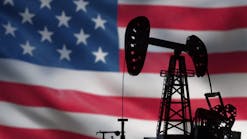Crippling of the Braer crude oil tanker, which led to its mangling on near shore rocks of the Shetland Islands Jan. 5, apparently was caused by steel pipes stored on deck, which worked loose in heavy seas and damaged fuel vent pipes.
Seawater leaked into a diesel fuel storage tank, leading to an engine shutdown. Heavy seas kept the crew from getting on deck to drop the anchors and stop the ship's drifting.
A Jan. 24 inspection by divers, after the seas calmed, showed no cargo oil or bunker fuel left on board (OGJ, Feb. 1, p. 17). All had spilled into the sea.
A report on circumstances leading up to the grounding of the Braer was prepared by Braer owner B&H Ship Management, Stamford, Conn., to "dispel guesswork and speculation."
BEFORE THE ACCIDENT
An annual inspection by the U.S. Coast Guard in November 1992 showed the Braer and its crew to be without deficiency, B&H said. Last Dec. 31 the ship passed a 48 point safety check at the Mongstad, Norway, terminal.
Braer sailed from Mongstad terminal, operated by Den norske stats oljeselskap AS, Jan. 3 bound for Ultramar Canada Inc.'s refinery at St. Romuald, Que.
Braer carried 607,000 bbl of Gullfaks field crude oil, 12,000 bbl of bunker fuel, and 900 bbl of diesel fuel. The crew sailed the vessel along the customary direct route, B&H said, through the 25 mile wide strait between Shetland and Fair Isle off northern Scotland. Bad weather had been forecast.
"More northern alternative routes would have been subject to worse weather and the presence of hazardous oil installations," B&H said. "The southern alternative would have been the English Channel, which is narrower and carries risks associated with traffic density and fog, and still without assurance of favorable weather.
Therefore the alternatives to the direct route were less attractive from the standpoint of safety and navigation."
LOOSE PIPES
Braer hit rough weather shortly after leaving Mongstad. An accommodation ladder, a lifeboat, a number of oil drums, and a rack of spare 16 ft steel pipes were secured on deck. But the pipes broke loose Jan. 4, and the weather was so rough no one could go on deck to secure or jettison them.
The four loose pipes, each weighing more than 1,000 lb, are the most likely cause of damage to air vent pipes for the ship's two diesel fuel tanks. The damage allowed seawater to run down the pipes into the diesel tanks.
The ship's 20,300 bhp engine, which ran on heavy fuel oil, relied on a boiler to lower the viscosity of the fuel oil enough to allow it to be injected into the engine. The engine and the boiler were started on diesel fuel, which also was burned in the engine during maneuvering.
"During the 2000-2400 hours watch Jan. 4, the watch engineer shut down the boiler to perform a routine adjustment," B&H said. "When this was completed, he relit the boiler as customary on diesel oil.
"To avoid damage, the boiler must be heated gradually, requiring that it be several times shut down and immediately restarted until warm enough to generate full steam pressure without damage.
"After several sequences of shutting down and relighting, the boiler failed to reignite."
TROUBLESHOOTING
The third assistant engineer, who had been watch engineer, was trying to find the trouble when the watch changed. He stayed on after midnight, to continue troubleshooting, when the second assistant engineer took charge.
By now the fuel oil had cooled and become more viscous, so the main engine fuel was switched from heavy oil to diesel fuel. The engine's diesel supply came from a 70 bbl service tank in the engine room, fed from a similar settling tank.
The boiler, however, was fed directly from the settling tank and proved difficult to restart. Engineers tested for water in the diesel tanks. When they opened the drain to the settling tank, a slug of water came out.
Repeated elimination of water failed to allow the boiler to refire for more than a few minutes at a time. Each time the boiler was fired, more water was found in the settling tank.
At about 0230 hours Jan. 5 the chief engineer was called to the engine room. The engines and generators operated normally from pure diesel remaining in the service tank. Efforts to fire up the boiler failed.
"The chief engineer therefore recommended that the master accordingly order an alteration of course to head for a safe anchorage," B&H said. "The plan was to find a lee for the ship that would permit the settling out, draining, and refilling of settling and service tanks, as well as locating and remedying the source of seawater into those tanks."
POWER FAILURE
At 0436 hours Braer changed course toward anchorage near Beatrice field in North Sea Block 11/30a in the Moray Firth. As the ship settled on its new course it lost engine power. Minutes later the generators failed, and the ship was blacked out except for emergency lighting.
The Braer was now 10 miles south of Sumburgh Head on Shetland. The master calculated the ship would drift clear of land int(; the North Sea and so did not immediately call for tugs.
At 0505 hours the coast guard at Aberdeen was alerted. Aberdeen passed the information on to Lerwick coast guard on Shetland. Lerwick called the Braer at 0519 hours and by 0545 was trying to locate a tug.
At 0604 hours the Star Sirius tug/supply vessel was made available and was under way at 0710 hours on the 3 hr journey to the Braer. Meanwhile, the coast guard arranged to lift crewmen from the Braer by helicopter.
A helicopter lift was "...no small feat as she (the Braer) was continuing to roll and pitch, taking green sea across her main deck," B&H said. "This condition prevented any consideration of trying to anchor the vessel because no one could go forward."
At 0825 hours the first helicopter departed with 16 crew members. Twenty-five minutes later a second helicopter rescued the remaining IS men.
The Star Sirius arrived at 0945 hours. A helicopter carried a team of volunteers back to the Braer to attempt to anchor the ship or conncect a tow line to the Star Sirius.
"None could be landed on the bow due to heavy sea washing aboard, so anchoring remained out of the question," B&H said. "Four (cremen) were landed on the afterdeck, and the second rocket line fired by Star Sirius was caught by the boarding party.
"During this process, Star Sirius was at times on the crest of a wave, high above the Braer, while on the next wave the Braer would ride the crest, as much as 50 ft above the Star Sirius in the trough below.
"Under those circumstances, it is not surprising that the effort to pull a messenger line from the tug to the ship was very soon thwarted by the heavy sea, just as the Braer was thrust by the sea onto the rocks off Garth's Ness. With safety of life at this point the prime consideration, the men on board were once more lifted off by helicopter."
Copyright 1993 Oil & Gas Journal. All Rights Reserved.


